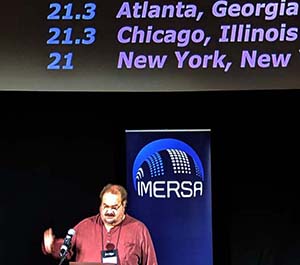State of the (Full)Dome 2019
by Mark C. Petersen, Loch Ness Productions
Adapted from a presentation at the IMERSA Summit,
Columbus, Ohio February 2019
As perspective for pondering the future of fulldome as a medium and market, it is useful to review its current state. Statistics drawn from Loch Ness Productions' DOME THEATER COMPENDIUM are presented and discussed, and provide some answers to the quintessential questions: "Who are we, where are we, and what are we doing?"
It's raining soup — grab a bucket!
By that I mean there's a wealth of information about our fulldome industry online. Those of you who have heard me present in previous years already know that Loch Ness Productions curates two extensive fulldome databases — one for theaters, and one for shows. I'll summarize some salient points from these resources.
Let's take planetarium theaters first. You already have access to the same data I have, because we publish it on our Web site: the LNP Fulldome Theater Compendium. You get there from the Reference tab on every page.
Select the country you want to look at, then just scroll through the listings. Where they are, what equipment they have, the staffpeople to contact — they're all there for the viewing. When I captured this page, there were 1,621 locations.
Two years ago, the last time I presented this talk at IMERSA, there were 1417 locations worldwide. We've added two hundred more since then. The U.S. saw an increase of 83 during that time, making up a little under half the new entries. So there it is, 1621 is our max customer base; that's all the planetarium theaters there are to provide fulldome to.
Now if you're a content provider, you may say "100 per year? There's a growing market for my work". Well, let's look more closely at these theaters. These next few demographics haven't changed much over the years.
This is the breakdown of fulldome theaters by the size of their domes. The US has more mid-size domes than internationally, but everywhere else there are more large and small domes than there are here.
Note that there are so many little domes. Many are portables.
I know content providers are most interested in the really big theaters — those with a 21-meter or bigger dome; you know, the ones with all the money. Yeah, well, there are only a dozen in the US. Here they are:
While the biggies are all in the MUSEUM/SCIENCE CENTER classification, the institutions that run fulldome theaters are almost ALL educational in nature.
Whether they're in a school or a school district, a university or college, many consider their primary mission to provide educational enlightenment to the masses. And of course, if it says "PLANETARIUM" on the wall outside, people expect to find stars and stuff on the inside.
This presents a challenge for those of us who create and distribute shows. We hear the question "Why isn't there more non-astronomy fulldome content out there?" Well, when a planetarium presents non-astronomy content, they're often working at odds to their own mission statements of astronomy education. They may express interest in non-astronomy content, but that doesn't necessarily mean they'll be sending their purchase orders for it.
Let's review what it is we've been feeding the theater operators — fulldome shows, of course.
This data is yours too — we've been curating it for years now, and it's a very popular online resource — the LNP Fulldome Show Compendium. Go there and you find pretty much every commercial show that's on the market today. We do highlight — in green — the shows that Loch Ness Productions distributes. It is our Web site, after all. But if we don't distribute a show, we still list it, and provide links to the producer's Web page for the show. Want to see a preview? Click the "View" button, and it opens a window with the preview that's on YouTube or Vimeo. Want to know how much the license costs? Click on the "Prices" button, and it takes you to the show's "Ordering" page. It's a lot faster than some other online databases, there's no membership or login required, and no ads!
You just scroll through the list to find what you're looking for. The columns are sortable — if you're looking for the newest shows, click on "YEAR" and the screen redraws with shows in chronological order; new shows will be at the top. Looking for a show that's less than 20 minutes? Sort by Duration and scroll. Looking for kiddie shows? Sort by Audience. Looking for non-astronomy content? Well, good luck with that.
There are nearly 350 commercially-available show titles in our database. If you sort those by genre, you'll see the overwhelming number are in the "Earth/Space" category. That hasn't changed from previous years either.
Two years ago, I put up this chart — the data sorted by Year. It documents the rise and fall of our professional existence.
I said at the time that I doubted the significant downhill trend would ever reverse itself and climb again. Two years later — was I right?
Yep. We may have reached a saturation point for show content and titles for planetarium theaters.
Well, we can only hope that things will improve in the future. I look forward to hearing your thoughts about that during this summit.
Check out the databases yourself. Make bookmarks to these pages. Send me updates, please. I'm doing this for you.
If you find this information useful, you can help support our efforts. Please go here or here or here.












